Lie of the Land
Britain’s Hidden Wonders in Countryfile
Wednesday, 21 December, 2011.

For further details check out the Countryfile Magazine website.
Comments
A signed paperback of The Lie of the Land
Friday, 02 December, 2011.
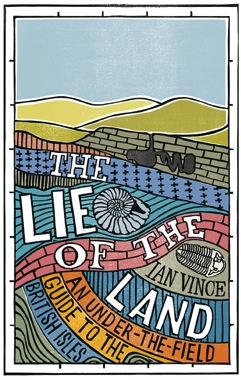
Click the Buy Now button below to order one securely through PayPal. If you want a personal inscription, send us a note via the contact form and Ian will oblige. Books are sent out the next working day.
Inspiration for a Grand Tour
Friday, 19 August, 2011.
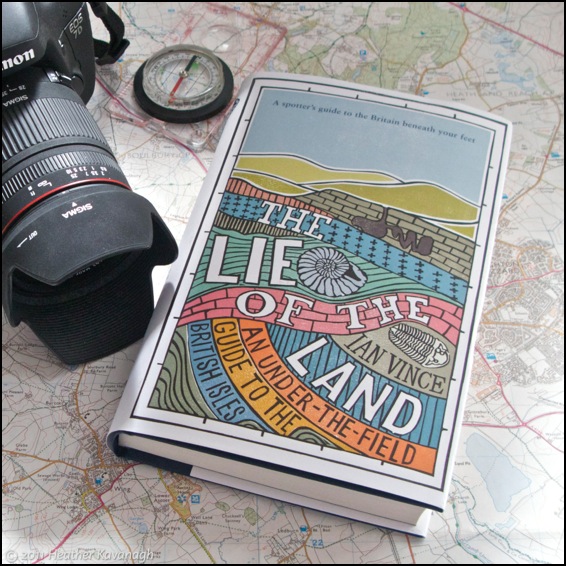
Photo: © 2011 Heather Kavanagh with thanks
It was lovely to hear recently that The Lie of the Land has inspired some of the thinking behind one reader’s retirement Grand Tour. Though only in the early planning stages at the moment, the very idea of Snaptophobic’s trip is particularly heartening because discovering Britain and realising how exotic it really is was one of the guiding thoughts behind the book and the club.
Do check out the rest of her blog as well.
Support your local independent bookstore
Wednesday, 08 June, 2011.
For people who have requested availability of The Lie of the Land in local independent book shops, try ordering from the Hive - a new initiative that ties up hundreds of independent booksellers across Britain to a slick web ordering mechanism. You buy the book - often at a reasonable discount - and then have it delivered free to your local shop, where you collect it. You can then wander around your local bookseller and see what else they have selected, without having to negotiate a wall of celebrity autobiographies and ‘inspiring’ hard-luck misery memoirs.
Here are the links to the hardback and paperback.
Here are the links to the hardback and paperback.
The Lie of the Land
2011 Outdoor Book of the Year
Wednesday, 01 June, 2011.
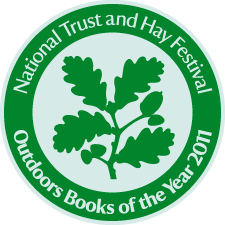
The endorsement, the result of a month-long poll to find the best recent writing about nature and the outdoors is shared with The Natural Navigator by Tristan Gooley, The Garden in the Clouds by Antony Woodward, Weeds by Richard Mabey and a number of other lovely books written from unique perspectives on the countryside. Hundreds of votes were cast and the winners were revealed at the Hay Festival - Britain’s most famous literary festival.
The British Landscape Club and Ian would like to thank everyone who voted for The Lie of the Land.
The Lie of the Land
and the People’s Book Prize
Friday, 14 January, 2011.

The People’s Book Prize is a new competition where there is no panel of judges - except the public. Vote for your non-fiction favourite at http://www.peoplesbookprize.com/section.php?id=2 - you have to register first to prevent any underhand behaviour (my underhand behaviour, not yours), but you get to vote for up to three books in each category. Voting for this round closes in February.
The Dabbler: The Lie of the Land
Thursday, 21 October, 2010.
Today I’m explaining - without the benefit of garbled technobabble and jargon - what connections can be made between a landscape and its underlying geology. Take a peek at The Dabbler website for my mini-post.
Buy a signed copy of The Lie of the Land
Friday, 03 September, 2010.
The BLC is offering signed copies of The Lie of the Land for the special price of £13.00 including p+p - £2.00 less than the published price. The book has gathered some excellent reviews since it was published earlier in the summer (see below) mostly concentrating on what an informative, but light, read it is.
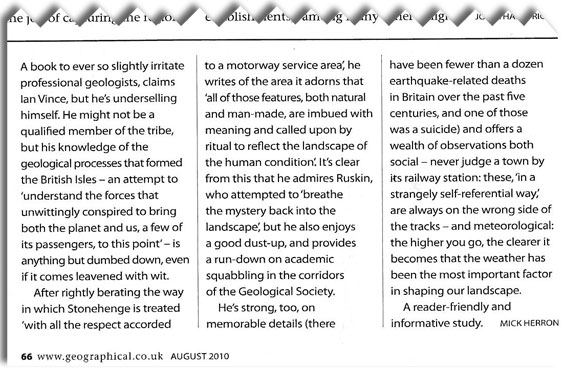
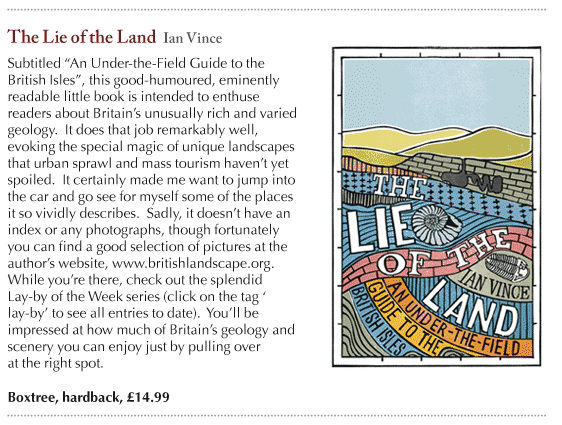
Dales Life
“Anyone who has ever picked up a pebble at the seaside or a rock on a moorland path will find invaluable Ian Vince's geological guide... you will understand the area round your British holiday cottage far more deeply than before.” Giles Foden (Author of The Last King of Scotland), Condé Nast Traveller
“Takes the reader on an explosive journey across millennia. Continents glide thousands of miles like contestants in Strictly Come Dancing, Scotland swelters on the Equator and Snowdonia boasts a volcanic ring of fire with mountains taller than Everest.” Daily Express
“Brings an easy touch to a subject most would leave to a hirsute geographer” The Field
“The English Channel is a relatively recent addition to the landscape, caused by two enormous floods which took place 450,000 and 200,000 years ago respectively, as huge, glacier-fed lakes burst their banks. Had it not been for these two inundations, Vince muses, the history of Britain - and even the world - could have turned out very differently” The Scotsman
“Far from a dry, scholarly tome, The Lie of the Land is brim full of facts dressed up in a lively narrative more akin to a fictional adventure. Vince is a passionate soul and natural wordsmith.” Western Morning News
“This is a layperson's guide to why the scenery in Britain is so varied. It starts in the far north-west of Scotland, describing and explaining the oldest rocks in the British Isles. It then explains the concept of geological time before starting a backwards journey from the most recent past. The geology of each period is explained with reference to its effects on the landscape we see around us and how the rocks were formed. There is a map with each chapter showing where rocks of the period being discussed are at the surface.
The book is written in a friendly and accessible style, with enough use of anecdote and humour to make it an enjoyable and relatively light read, while still being informative. There are suggestions for further reading in the back for anyone who wants to go into the geology in more detail. I enjoyed reading it even though (in theory) I should already know most of what it says. I would recommend this to anyone with an interest in landscapes.” Science File book reviews - sciencefile.org
To buy 1 copy for £13.00 inc p+p, click Buy Now below to pick up your copy and find out about the Britain beneath your feet. If you want more copies or first class post, go to the BLC shop


Dales Life
“Anyone who has ever picked up a pebble at the seaside or a rock on a moorland path will find invaluable Ian Vince's geological guide... you will understand the area round your British holiday cottage far more deeply than before.” Giles Foden (Author of The Last King of Scotland), Condé Nast Traveller
“Takes the reader on an explosive journey across millennia. Continents glide thousands of miles like contestants in Strictly Come Dancing, Scotland swelters on the Equator and Snowdonia boasts a volcanic ring of fire with mountains taller than Everest.” Daily Express
“Brings an easy touch to a subject most would leave to a hirsute geographer” The Field
“The English Channel is a relatively recent addition to the landscape, caused by two enormous floods which took place 450,000 and 200,000 years ago respectively, as huge, glacier-fed lakes burst their banks. Had it not been for these two inundations, Vince muses, the history of Britain - and even the world - could have turned out very differently” The Scotsman
“Far from a dry, scholarly tome, The Lie of the Land is brim full of facts dressed up in a lively narrative more akin to a fictional adventure. Vince is a passionate soul and natural wordsmith.” Western Morning News
“This is a layperson's guide to why the scenery in Britain is so varied. It starts in the far north-west of Scotland, describing and explaining the oldest rocks in the British Isles. It then explains the concept of geological time before starting a backwards journey from the most recent past. The geology of each period is explained with reference to its effects on the landscape we see around us and how the rocks were formed. There is a map with each chapter showing where rocks of the period being discussed are at the surface.
The book is written in a friendly and accessible style, with enough use of anecdote and humour to make it an enjoyable and relatively light read, while still being informative. There are suggestions for further reading in the back for anyone who wants to go into the geology in more detail. I enjoyed reading it even though (in theory) I should already know most of what it says. I would recommend this to anyone with an interest in landscapes.” Science File book reviews - sciencefile.org
To buy 1 copy for £13.00 inc p+p, click Buy Now below to pick up your copy and find out about the Britain beneath your feet. If you want more copies or first class post, go to the BLC shop
Browse The Lie of the Land
Tuesday, 17 August, 2010.
We’re delighted to be able to tell you that the unofficial manual of the British Landscape Club, The Lie of the Land by Ian Vince is now in a browsable condition online, with the permission of the publishers, Pan Macmillan. So dive in as if you were in a bookstore - there’s a selection of links at the bottom to buy it from if you fancy picking up a tangible copy or just want to read the whole darn thing.
Buy from
Buy from
Geographical Review
Monday, 16 August, 2010.
There’s a lovely review of the BLC manual The Lie of the Land in the August issue of Geographical Magazine, the official magazine of the Royal Geographical Society. I’ve clipped out the body of it below.


The Lie of the Land reviews
Friday, 13 August, 2010.
The Lie of the Land has garnered some nice reviews since publication - here are a few of them.

Dales Life
“Anyone who has ever picked up a pebble at the seaside or a rock on a moorland path will find invaluable Ian Vince's geological guide... you will understand the area round your British holiday cottage far more deeply than before.” Giles Foden (Author of The Last King of Scotland), Condé Nast Traveller
“Takes the reader on an explosive journey across millennia. Continents glide thousands of miles like contestants in Strictly Come Dancing, Scotland swelters on the Equator and Snowdonia boasts a volcanic ring of fire with mountains taller than Everest.” Daily Express
“Brings an easy touch to a subject most would leave to a hirsute geographer” The Field
“The English Channel is a relatively recent addition to the landscape, caused by two enormous floods which took place 450,000 and 200,000 years ago respectively, as huge, glacier-fed lakes burst their banks. Had it not been for these two inundations, Vince muses, the history of Britain - and even the world - could have turned out very differently” The Scotsman
“Far from a dry, scholarly tome, The Lie of the Land is brim full of facts dressed up in a lively narrative more akin to a fictional adventure. Ian is a passionate soul and natural wordsmith.” Western Morning News
There’s a lovely review of the BLC manual The Lie of the Land in the August issue of Geographical Magazine, the official magazine of the Royal Geographical Society. I’ve clipped out the body of it below.


Dales Life
“Anyone who has ever picked up a pebble at the seaside or a rock on a moorland path will find invaluable Ian Vince's geological guide... you will understand the area round your British holiday cottage far more deeply than before.” Giles Foden (Author of The Last King of Scotland), Condé Nast Traveller
“Takes the reader on an explosive journey across millennia. Continents glide thousands of miles like contestants in Strictly Come Dancing, Scotland swelters on the Equator and Snowdonia boasts a volcanic ring of fire with mountains taller than Everest.” Daily Express
“Brings an easy touch to a subject most would leave to a hirsute geographer” The Field
“The English Channel is a relatively recent addition to the landscape, caused by two enormous floods which took place 450,000 and 200,000 years ago respectively, as huge, glacier-fed lakes burst their banks. Had it not been for these two inundations, Vince muses, the history of Britain - and even the world - could have turned out very differently” The Scotsman
“Far from a dry, scholarly tome, The Lie of the Land is brim full of facts dressed up in a lively narrative more akin to a fictional adventure. Ian is a passionate soul and natural wordsmith.” Western Morning News
There’s a lovely review of the BLC manual The Lie of the Land in the August issue of Geographical Magazine, the official magazine of the Royal Geographical Society. I’ve clipped out the body of it below.

The geographical delights of Port Eliot
Wednesday, 28 July, 2010.
I’ve been away for a few days at Port Eliot for Part 1 of my official launch of the BLC - Part 2 is at Camp Bestival this weekend at 6.20 pm in the tent of the East Lulworth Literary Institute, along with some Jurassic thoughts.
Maybe I’ll see you there, but in the meantime, here are some shots of the Port Eliot landscape and some thoughts about it. The immediate area is a complex one with hard volcanic lavas, ash and ‘tuffs’ making up a west-east ridge of high ground to the estuaries of the Rivers Tiddy and Lynher, while two separate areas of rough slate - which the Cornish refer to as ‘killas’ - run to the north and south of the ridge. The Caught by the River tent was situated in a small quarry which may have provided some killas for the estate walls. You can see the high ground in the first picture and its continuation on the far side of the Tiddy in the second picture - the line of trees mark the course of a cutting that takes the Great Western line towards Plymouth. The lava and ash made their way into the landscape during a time that Southern Britain and Scotland were being welded together around 400 or so million years ago and a Himalayan range of mountains was being formed to the North.
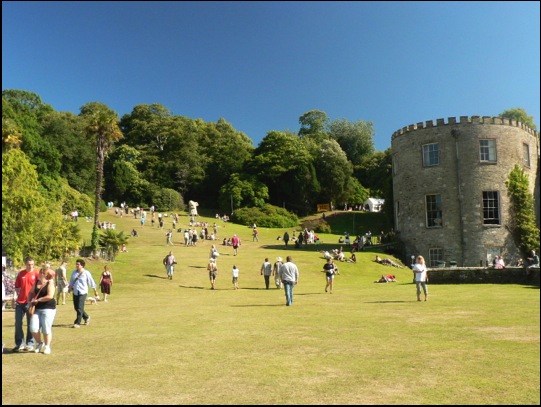
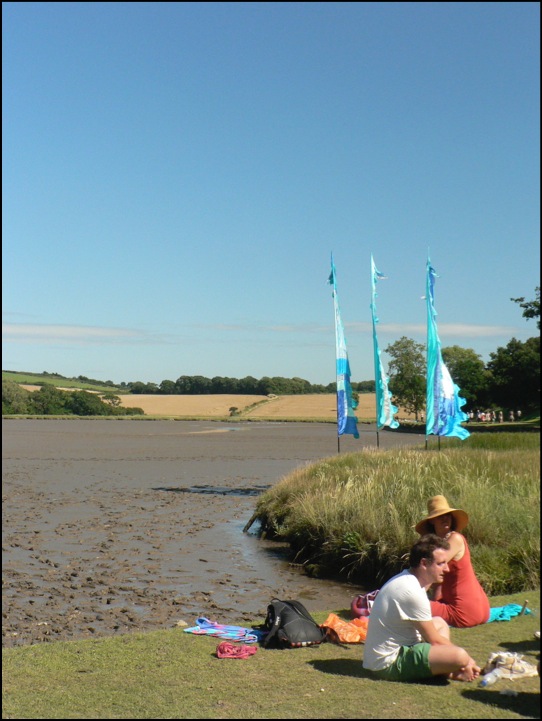

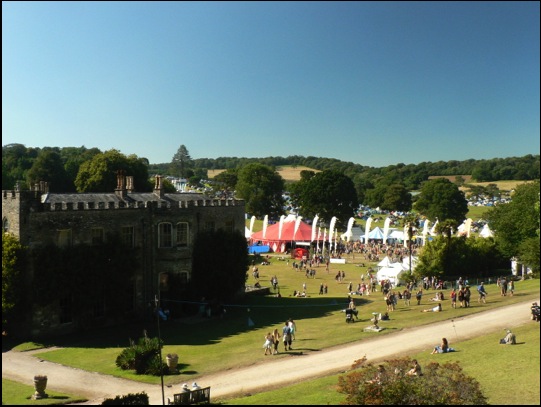
Maybe I’ll see you there, but in the meantime, here are some shots of the Port Eliot landscape and some thoughts about it. The immediate area is a complex one with hard volcanic lavas, ash and ‘tuffs’ making up a west-east ridge of high ground to the estuaries of the Rivers Tiddy and Lynher, while two separate areas of rough slate - which the Cornish refer to as ‘killas’ - run to the north and south of the ridge. The Caught by the River tent was situated in a small quarry which may have provided some killas for the estate walls. You can see the high ground in the first picture and its continuation on the far side of the Tiddy in the second picture - the line of trees mark the course of a cutting that takes the Great Western line towards Plymouth. The lava and ash made their way into the landscape during a time that Southern Britain and Scotland were being welded together around 400 or so million years ago and a Himalayan range of mountains was being formed to the North.




Lay-by of the week special:
The views from a Devon train
Wednesday, 14 July, 2010.
Back to our normal format next week on the nation’s A-rated, A-road Thermos stops, but I’ve taken the liberty of designating a number of trains in the South west of England as personal lay-bys and attempted to take pictures. They are variable in quality - some trains just seem to be smeared with a veneer of fly corpses, sea splatter and dirty rain. Sometimes polarising the sky for a nice effect also brings out the rectilinear strip light reflections that head off towards our destination, which is an effect I don’t mind too much.
The trains I travelled on were the Great Western 125 mph from Totnes to Exeter and the more modern but 90 mph from Exeter to Salisbury. On my way to Exeter, I was hoping to catch a good view of the fantastic New Red Sandstone cliffs around Dawlish, as featured in The Lie of the Land. I got something of it, through the fly carcasses, and it looks like an old double-exposed holiday slide that has been wedged under a shelf in the garage since the 1970s. It was, at least, nice to make something that came with an instant patina of age on a digital camera.
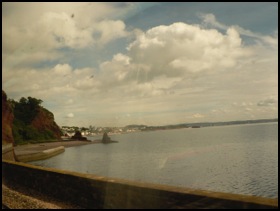
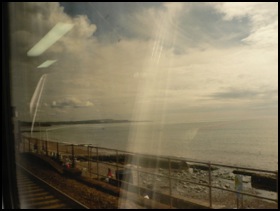
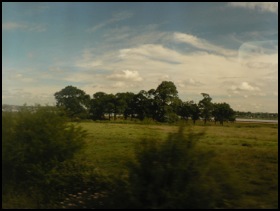
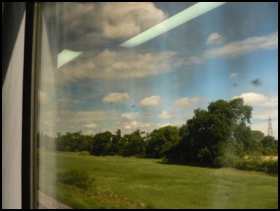
The second two shots are nearer Exeter, of clumps of trees on the Exminster Marshes. By the time that I had got on a cleaner train, I took some more presentable shots of the kind of thing you see from trains, this time mostly between Exeter and Yeovil. This first shot is of some trees in the Axe Valley - I’m hopeless at trees, but they’re in the right environment for Alder and Willow. I like the way they’re all leaning here, as if in agreement with one another.
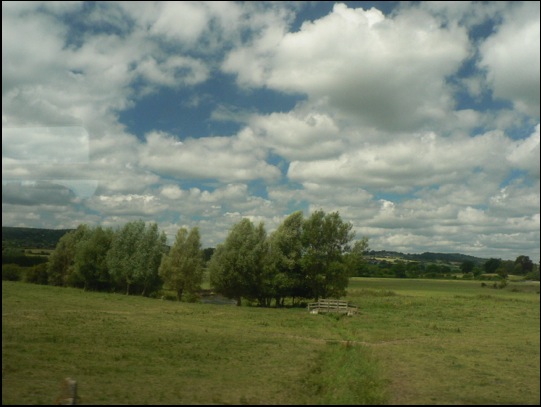
The second shot is quite near Yeovil. The reflections from the train’s internal lighting give the sky some go-faster stripes.
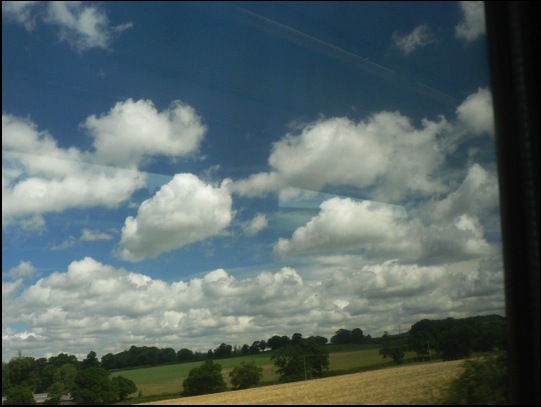
The trains I travelled on were the Great Western 125 mph from Totnes to Exeter and the more modern but 90 mph from Exeter to Salisbury. On my way to Exeter, I was hoping to catch a good view of the fantastic New Red Sandstone cliffs around Dawlish, as featured in The Lie of the Land. I got something of it, through the fly carcasses, and it looks like an old double-exposed holiday slide that has been wedged under a shelf in the garage since the 1970s. It was, at least, nice to make something that came with an instant patina of age on a digital camera.




The second two shots are nearer Exeter, of clumps of trees on the Exminster Marshes. By the time that I had got on a cleaner train, I took some more presentable shots of the kind of thing you see from trains, this time mostly between Exeter and Yeovil. This first shot is of some trees in the Axe Valley - I’m hopeless at trees, but they’re in the right environment for Alder and Willow. I like the way they’re all leaning here, as if in agreement with one another.

The second shot is quite near Yeovil. The reflections from the train’s internal lighting give the sky some go-faster stripes.

Lay-by of the week special
ROAM: The London Lay-by Library
Wednesday, 07 July, 2010.
Bit of a diversion off the A-roads of rural Britain this week into an old mobile library van parked close to an urban A-road or two: the ROAM London project.
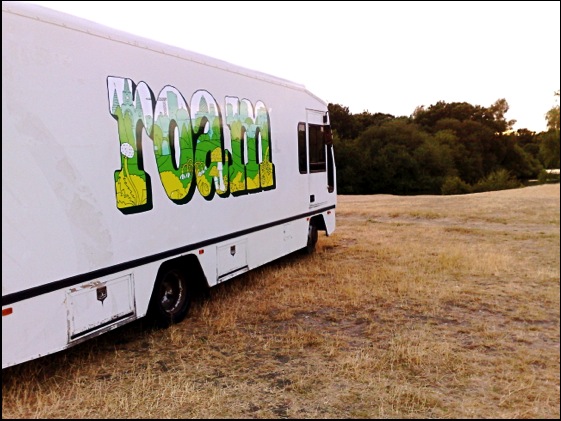
ROAM at Hollow Ponds, Whipps Cross Road
ROAM is touring the five Olympic boroughs of London over the next three weeks as a peripatetic arts space, a mobile reading room and a venue for talks and performance. It has its own reference library and comes complete with a proper parquet floor. It’s the idea of Caught By The River’s Robin Turner and fits well with that website’s general ethos of taking solace in easy, idle pursuits and looking for the rural within our urban lives.
I’ve already had the pleasure of taking the message of the British Landscape Club there and chatting about the Britain beneath its wheels and I’ll be doing it again three more times over the next week and a half, so come and join me.
Friday 9 July 3pm *NOTE NEW TIME*
Beneath Our Feet: Three Billion Years an Hour Through Britain’s Past
ROAM London: Haggerston Park • Parked up behind the tennis courts • E2 8NP
Friday 16 July 7.00pm
Beneath Our Feet: Three Billion Years an Hour Through Britain’s Past
ROAM London: Mile End Park • Grove Road • E3
*NOTE NEW VENUE* (Was at Truman Brewery)
Monday 19 July 7.30pm
Beneath Our Feet: Three Billion Years an Hour Through Britain’s Past
ROAM London: Oxleas Woods • Shooters Hill • SE18 3JA

ROAM at Hollow Ponds, Whipps Cross Road
ROAM is touring the five Olympic boroughs of London over the next three weeks as a peripatetic arts space, a mobile reading room and a venue for talks and performance. It has its own reference library and comes complete with a proper parquet floor. It’s the idea of Caught By The River’s Robin Turner and fits well with that website’s general ethos of taking solace in easy, idle pursuits and looking for the rural within our urban lives.
I’ve already had the pleasure of taking the message of the British Landscape Club there and chatting about the Britain beneath its wheels and I’ll be doing it again three more times over the next week and a half, so come and join me.
Friday 9 July 3pm *NOTE NEW TIME*
Beneath Our Feet: Three Billion Years an Hour Through Britain’s Past
ROAM London: Haggerston Park • Parked up behind the tennis courts • E2 8NP
Friday 16 July 7.00pm
Beneath Our Feet: Three Billion Years an Hour Through Britain’s Past
ROAM London: Mile End Park • Grove Road • E3
*NOTE NEW VENUE* (Was at Truman Brewery)
Monday 19 July 7.30pm
Beneath Our Feet: Three Billion Years an Hour Through Britain’s Past
ROAM London: Oxleas Woods • Shooters Hill • SE18 3JA
Beautiful geology
Monday, 28 June, 2010.
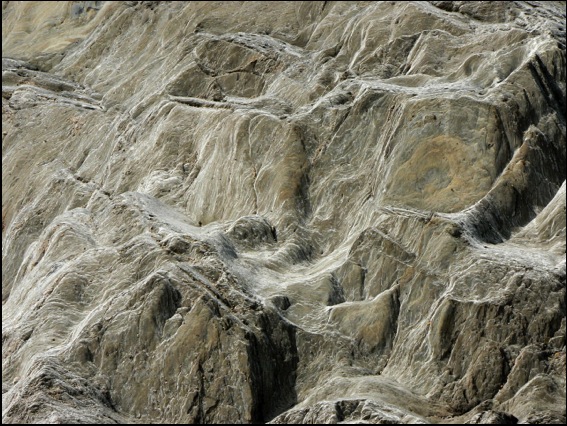
On the face of it, slate is not an inspiring material. Roofs built from it cover concentric rings of brick-built Victorian suburbs around most of our larger cities while the holes in the ground that were left behind are - I would venture - only really at their most thrilling when you are unfortunate enough to be plummeting to a brutal and untidy death at the foot of one.
But look at these pictures of not just any-old slate but, rather, some fairly poor-quality slate (in terms of building materials, that is) on the coast of South Devon. This particular outcrop has probably been attacked by waves twice daily for thousands of years and has started to acquire something of a liquid texture as if mimicking its tormentor.
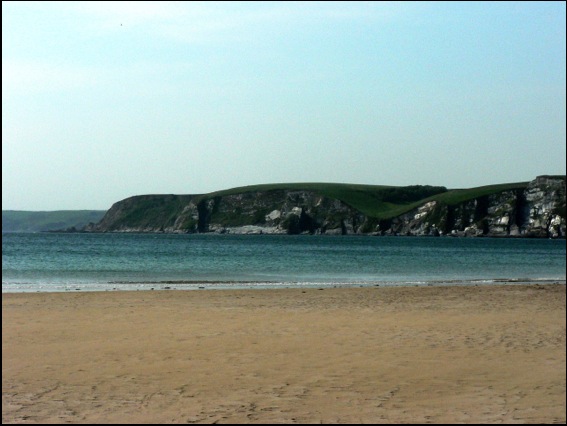
When viewed from a distance, the cliffs formed from this poor slate, which has a lustrous glaze about it when you find one of its pebbles on the beach, gleam in low sunshine like a washing line in a detergent advertisement. And this is all just a rather poor-quality Devonian slate.
Monstrous Carbuncle
Friday, 25 June, 2010.
I like Dorset - as mentioned in this week’s Lay-by of the Week, it is where a lot of the ideas for The Lie of the Land came from and it is a county that seems to have as many different facets as it has market towns.
But one of those towns – and not just any old market town, but Dorset’s county town – will never be the same again. For Dorchester has been tainted by its association with the monstrous carbuncle that is HRH Prince Charles’ Poundbury or, to give it a name accidentally arrived at in a Freudian slip of the tongue, Poundland.
View Monstrous Carbuncle in a larger map
This grotesque and repulsive display of architectural pus sits on the eastern horizon as you approach Dorchester from the west. The awful buildings infect the surrounding landscape with their weak-minded parody of a passing resemblance to a rough similarity to a half-remembered Tuscan hill-top village. Who-ever presided over this inferior and wholly unaesthetic effort should be shot through the lungs with high-velocity 2H pencils.
Some of Poundbury is well-executed, even if it is obviously the work of a cobwebbed mind. While the Duke of Cornwall proclaims his love of traditional vernacular architecture and actually has interesting and useful ideas about the sustainability of communities, his biggest showcase looks like a malformed bleb from the side of the A35.
But one of those towns – and not just any old market town, but Dorset’s county town – will never be the same again. For Dorchester has been tainted by its association with the monstrous carbuncle that is HRH Prince Charles’ Poundbury or, to give it a name accidentally arrived at in a Freudian slip of the tongue, Poundland.
View Monstrous Carbuncle in a larger map
This grotesque and repulsive display of architectural pus sits on the eastern horizon as you approach Dorchester from the west. The awful buildings infect the surrounding landscape with their weak-minded parody of a passing resemblance to a rough similarity to a half-remembered Tuscan hill-top village. Who-ever presided over this inferior and wholly unaesthetic effort should be shot through the lungs with high-velocity 2H pencils.
Some of Poundbury is well-executed, even if it is obviously the work of a cobwebbed mind. While the Duke of Cornwall proclaims his love of traditional vernacular architecture and actually has interesting and useful ideas about the sustainability of communities, his biggest showcase looks like a malformed bleb from the side of the A35.
Lay-by of the week: Askerswell from the A35
Wednesday, 23 June, 2010.
This week I can tie three loose ends and write not only about lay-bys, but also the Dorset landscape and the road trip that triggered me into writing The Lie of the Land in the first place.
View Larger Map
One bright and crisp winters day a short breath after Christmas, we were driving through Dorset as we made our way back from Cornwall. The journey was quite familiar to me and I had never given it much thought. A couple of years before, I had come the closest to thinking deeply about travel when two friends and I covered the same ground as part of an epic, 15 mph journey across England in an electric milk float but, crucially we had picked a different route for this stretch.
I was on the A35, a murderously busy road we had escaped from while on the float - a quick turn-off that happened to land us in Arcadia, an enchanted valley near Little Bredy trapped somewhere between dusk and the early 1950s. It was the encapsulation of pastoral beauty and I will remember the scene for ever.
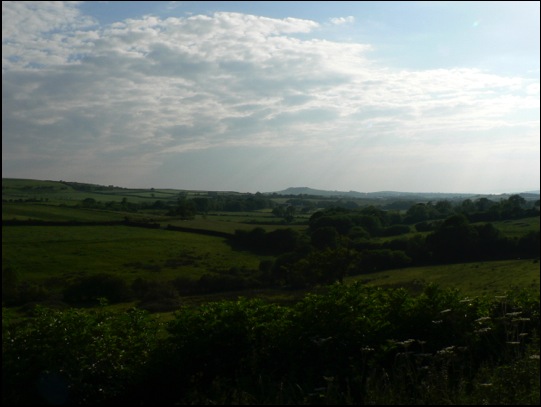
As so often happens in Britain though, by catching one thing, you miss another and the A35 - for all its homicidal ways - is the scene of something on a par with our Dorset Arcadia but in a different way. The stretch of it we avoided, between Dorchester and Bridport, affords awe-inspiring views of the lumpy, bumpy Dorsetshire hills, the festival of buxom hummocks that made it into the introduction to The Lie of the Land.
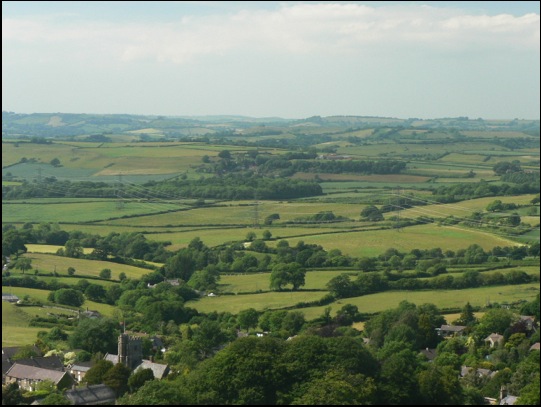
As ever, all attempts to capture such grandeur on a soul-less semiconductor fail miserably. I’ve taken my version of the Google Street View, but the best stuff is on the other side of the road when the road reaches its height and the views over the Dorset coast are breathtaking. You really have to see the view for yourself.
View Larger Map
One bright and crisp winters day a short breath after Christmas, we were driving through Dorset as we made our way back from Cornwall. The journey was quite familiar to me and I had never given it much thought. A couple of years before, I had come the closest to thinking deeply about travel when two friends and I covered the same ground as part of an epic, 15 mph journey across England in an electric milk float but, crucially we had picked a different route for this stretch.
I was on the A35, a murderously busy road we had escaped from while on the float - a quick turn-off that happened to land us in Arcadia, an enchanted valley near Little Bredy trapped somewhere between dusk and the early 1950s. It was the encapsulation of pastoral beauty and I will remember the scene for ever.

As so often happens in Britain though, by catching one thing, you miss another and the A35 - for all its homicidal ways - is the scene of something on a par with our Dorset Arcadia but in a different way. The stretch of it we avoided, between Dorchester and Bridport, affords awe-inspiring views of the lumpy, bumpy Dorsetshire hills, the festival of buxom hummocks that made it into the introduction to The Lie of the Land.

As ever, all attempts to capture such grandeur on a soul-less semiconductor fail miserably. I’ve taken my version of the Google Street View, but the best stuff is on the other side of the road when the road reaches its height and the views over the Dorset coast are breathtaking. You really have to see the view for yourself.
Welcome...
Wednesday, 16 June, 2010.
The British Landscape Club is featured on the Guardian website today in the form of a small slideshow of some of the oldest bits of Britain.
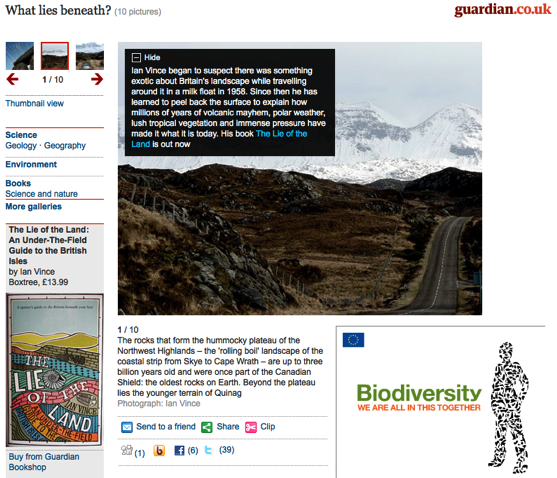
A big welcome to you if you have discovered us via the Guardian and please consider joining the BLC. There’s at least one good reason and that is that it’s completely free and there’s also a rather fetching and free badge. No catches, just tell us where to send it and we will pop in a small sampler of Chapter 1 of The Lie of the Land. That’s it. No hard sell - just relax and enjoy the view.
Join the BLC for free.

A big welcome to you if you have discovered us via the Guardian and please consider joining the BLC. There’s at least one good reason and that is that it’s completely free and there’s also a rather fetching and free badge. No catches, just tell us where to send it and we will pop in a small sampler of Chapter 1 of The Lie of the Land. That’s it. No hard sell - just relax and enjoy the view.
Join the BLC for free.
The Lie of the Land is launched
Friday, 04 June, 2010.
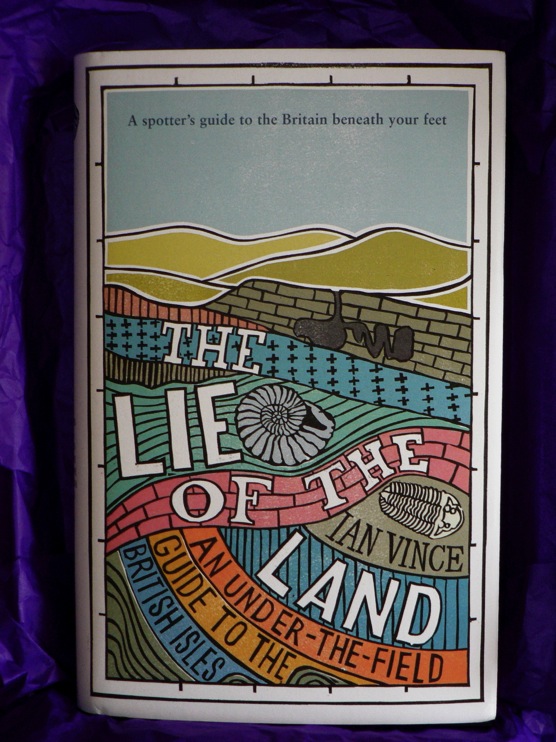 Today, Friday June 4, is the official publication date of The Lie of the Land, the BLC’s unofficial under-the-field guide to the British landscape, as written by Ian Vince The Lie of the Land was written over the course of 14 months during 2009 and 2010 as Ian travelled back and forth across Britain to tell the truly extraordinary story of how our beautiful landscape was formed.
Today, Friday June 4, is the official publication date of The Lie of the Land, the BLC’s unofficial under-the-field guide to the British landscape, as written by Ian Vince The Lie of the Land was written over the course of 14 months during 2009 and 2010 as Ian travelled back and forth across Britain to tell the truly extraordinary story of how our beautiful landscape was formed.Needless to say, it is available in all good bookshops, as well as their online counterparts, Amazon, Waterstones and Pickabook. Ian would obviously love you to go and buy it in your droves but not just so that he can write something along similar lines for the next one, but also because the book’s message is all about celebrating the awesomely fascinating landscapes we are lucky enough to have in Britain.
The Lie of the Land is available…
Wednesday, 02 June, 2010.

The Lie of the Land is officially published on the June 4 but online retailers including Amazon, Waterstones and Pickabook are now dispatching copies so you can have it in time for official pub. day (this is the day - among many others - that you can find authors in the pub).
Less than three weeks to go...
Monday, 17 May, 2010.
It’s less than three weeks to go until The Lie of the Land, by the BLC’s Ian Vince, is published by Macmillan. A kind of unofficial BLC manual and a rough ‘under-the-field guide’ to Britain, The Lie of the Land was written during 2009 as Ian travelled back and forth across Britain to tell the truly extraordinary story of how our beautiful landscape was formed.
The Lie of the Land is published on the June 4 and Ian will be talking about it here and there over the next few weeks - keep an eye on the BLC website for more details of events in London and Devon among others, but in the meantime, we can reveal that he will be on BBC Radio 4’s travel magazine, Excess Baggage, on the morning of June 5.
You can order the book in all the usual places including Amazon, Waterstones and your local bookshop.

The Lie of the Land is published on the June 4 and Ian will be talking about it here and there over the next few weeks - keep an eye on the BLC website for more details of events in London and Devon among others, but in the meantime, we can reveal that he will be on BBC Radio 4’s travel magazine, Excess Baggage, on the morning of June 5.
You can order the book in all the usual places including Amazon, Waterstones and your local bookshop.

Lay-by of the week: Kylesku, Highlands
Tuesday, 11 May, 2010.
Almost at the end of the old road to the Kylesku-Kylestrome ferry that once took all the traffic of the A894 west coast road, this lay-by would have once given you something fantastic to look at while you were waiting for the boat to arrive.
The view is of Loch Glendhu stretching off into the distance while Loch Glencoul forks, unseen, behind the nearest headland to the right. The die-straight diagonal line on the mountain behind the lamp-post is the fault plane of the Glencoul Thrust, one of a number of landscape movements caused by the joining of Scotland - originally part of the same landmass as North America - to the rest of Britain over 400 million years ago. Land was folded, fractured then heaved dozens of miles from the west, from the north at Durness all the way down the west coast to the Isle of Skye.
View Larger Map
Although the ferry no longer carries traffic across the Loch to Kylestrome, there are still boat trips from Kylesku - most notably up Loch Glencoul, from where you can enjoy superb views of Eas a’ Chùall Aluinn, at 658 feet, Britain’s highest waterfall.
The view is of Loch Glendhu stretching off into the distance while Loch Glencoul forks, unseen, behind the nearest headland to the right. The die-straight diagonal line on the mountain behind the lamp-post is the fault plane of the Glencoul Thrust, one of a number of landscape movements caused by the joining of Scotland - originally part of the same landmass as North America - to the rest of Britain over 400 million years ago. Land was folded, fractured then heaved dozens of miles from the west, from the north at Durness all the way down the west coast to the Isle of Skye.
View Larger Map
Although the ferry no longer carries traffic across the Loch to Kylestrome, there are still boat trips from Kylesku - most notably up Loch Glencoul, from where you can enjoy superb views of Eas a’ Chùall Aluinn, at 658 feet, Britain’s highest waterfall.
Win a hamper in our landscape photo competition.
Monday, 26 April, 2010.
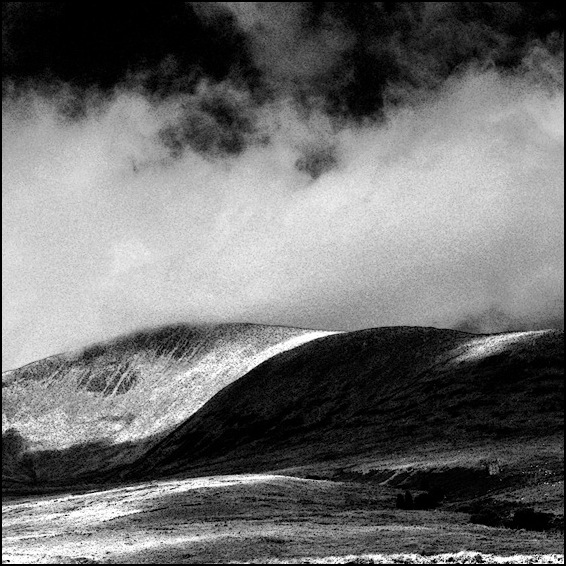
To celebrate the launch of Lie of the Land, The British Landscape Club’s under-the-field-guide to the British landscape, we are running a photography competition to find Britain's best photographed landscape.
So get snapping those buxom hummocks, discordant coastlines and stone circles and submit them to the Lie of the Land Flickr photo pool at http://www.flickr.com/groups/lieoftheland/.
The winner - who will win a lovely picnic hamper - will be announced July 30 2010 Leading up to the announcement we will feature ten photos a week right here on the website. There will be also be runner-up prizes of signed copies of Lie of the Land.
For general competition terms and conditions go to:
http://www.panmacmillan.com/displayPage.asp?PageID=3823
Please be assured that your photos will only be used in connection with this competition and any publicity it generates - which may include the websites of national and local newspapers. The submitter retains all copyright to their photos and the right to a byline/credit where ever it is used.
British Volcanoes: Ardnamurchan
Tuesday, 20 April, 2010.
If your holiday plans are threatened by geological violence this year, why not make the most of the disruption and stay in Britain instead? After all, there’s no need to be stranded on the other side of the world in pursuit of amazing landscapes when we have more than enough of our own - and that includes volcanoes.
At the risk of sounding like a Travelodge brochure, Britain’s volcanic heritage can be discovered in many locations across the UK from the wilds of Ardnamurchan to the slopes of Snowdonia - there are even city centre volcanoes for your convenience. We’ll be looking at all of these over the next few weeks, but we’re starting at mainland Britain’s most westerly point - not Land’s End as is popularly supposed, but the Point of Ardnamurchan in Scotland.
View Larger Map
The Ardnamurchan Peninsula, seen here courtesy of Google, was the site, around 65 million years ago, of intense volcanic activity. Over a period of approximately three million years, the Ardnamurchan volcano would have undergone a series of awe-inspiring eruptions culminating in the collapse of the cone and crater onto the chamber of molten rock beneath, forming the caldera - the remains of which we see today. The hotspot that created it may even be the same plume that now lies under Iceland obstructing your travel plans.
In the intervening period, wind, rain and, the most destructive of them all, glacial ice, have worn down the landscape. The following image is from the southern part of the crater itself, while the view north - like most of the journey along this road - is obstructed by the lie of the land.
View Larger Map
At the risk of sounding like a Travelodge brochure, Britain’s volcanic heritage can be discovered in many locations across the UK from the wilds of Ardnamurchan to the slopes of Snowdonia - there are even city centre volcanoes for your convenience. We’ll be looking at all of these over the next few weeks, but we’re starting at mainland Britain’s most westerly point - not Land’s End as is popularly supposed, but the Point of Ardnamurchan in Scotland.
View Larger Map
The Ardnamurchan Peninsula, seen here courtesy of Google, was the site, around 65 million years ago, of intense volcanic activity. Over a period of approximately three million years, the Ardnamurchan volcano would have undergone a series of awe-inspiring eruptions culminating in the collapse of the cone and crater onto the chamber of molten rock beneath, forming the caldera - the remains of which we see today. The hotspot that created it may even be the same plume that now lies under Iceland obstructing your travel plans.
In the intervening period, wind, rain and, the most destructive of them all, glacial ice, have worn down the landscape. The following image is from the southern part of the crater itself, while the view north - like most of the journey along this road - is obstructed by the lie of the land.
View Larger Map
Lay-by of the Week: Llyn Ogwyn
Friday, 16 April, 2010.
Back to Wales for this lay-by, sent in by BLC member SteveP
View Larger Map
Steve writes, “There are several lay-bys on this stretch of the A5 which are very popular with outdoorsy people. Looking west you can see Y Garn which has a nice cwm. and SSE you can see Tryfan, probably one of the best mountains in Wales. You can also see Llyn Ogwen, the lake alongside the road. You might prefer the lay-by closer to Ogwen Cottage as you can get a cup of tea there.”
Feel free to re-tweet the permalink and, as ever, if you have a favourite stopping-off point to view the scenery over a cup of warm thermos tea, drop us a line or leave a note in the forum.
View Larger Map
Steve writes, “There are several lay-bys on this stretch of the A5 which are very popular with outdoorsy people. Looking west you can see Y Garn which has a nice cwm. and SSE you can see Tryfan, probably one of the best mountains in Wales. You can also see Llyn Ogwen, the lake alongside the road. You might prefer the lay-by closer to Ogwen Cottage as you can get a cup of tea there.”
Feel free to re-tweet the permalink and, as ever, if you have a favourite stopping-off point to view the scenery over a cup of warm thermos tea, drop us a line or leave a note in the forum.
Lay-by of the Week: Passing Place special
Wednesday, 31 March, 2010.
Not strictly a lay-by, but a series of passing places along a road through the Pre-Cambrian heartland of South Shropshire, near Church Stretton. Follow the arrows down to the village and admire the views on your way down.
View Larger Map
View Larger Map
